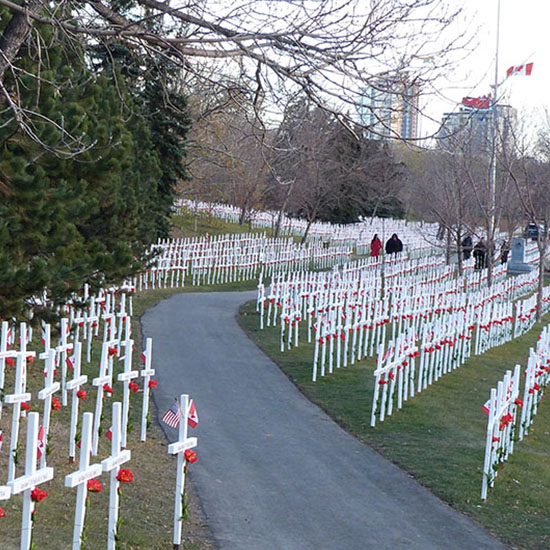
Field of Crosses lit by 3,000 candles on eve of Nov. 11
The Field of Crosses alongside Memorial Drive was lit up Sunday night by more than 3,000 candles in honour of the sacrifices made by Canadian soldiers. "There's five acres of crosses here and each one of them was a real human being who got on a train, probably at the...
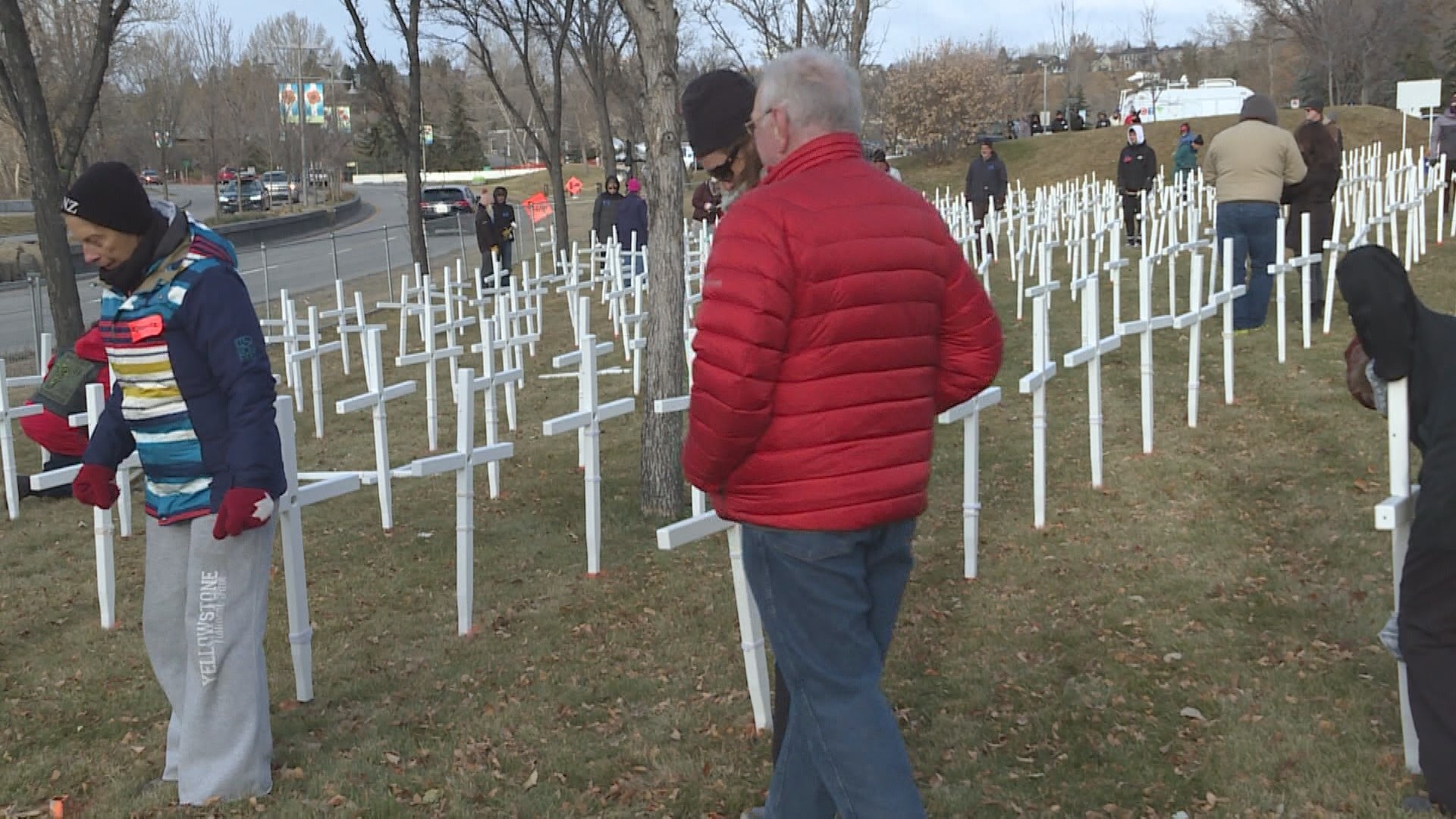
How you can participate in Calgary’s 2019 Field of Crosses commemorations
Tom Leppard and Murray McCann of the Field of Crosses Memorial join Global News Morning Calgary to discuss how you can participate in the 2019 commemorations. Watch the video
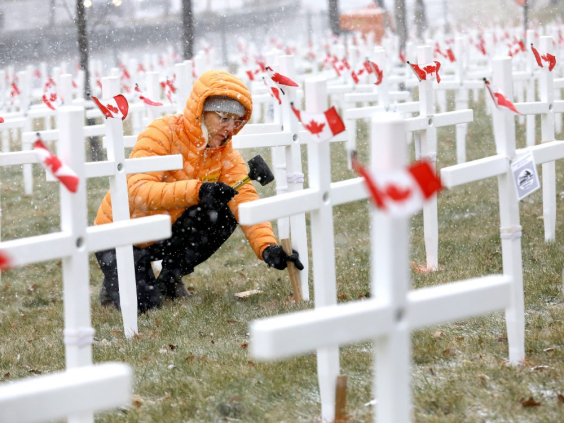
Field of Crosses returns to Memorial Drive ahead of Remembrance Day
It’s a stirring reminder of the sacrifices made by Canadian soldiers, and for the 11th year running row upon row of white crosses are being installed along Memorial Drive just in time for Remembrance Day. Hundreds of volunteers began placing some 3,400 of the ivory...
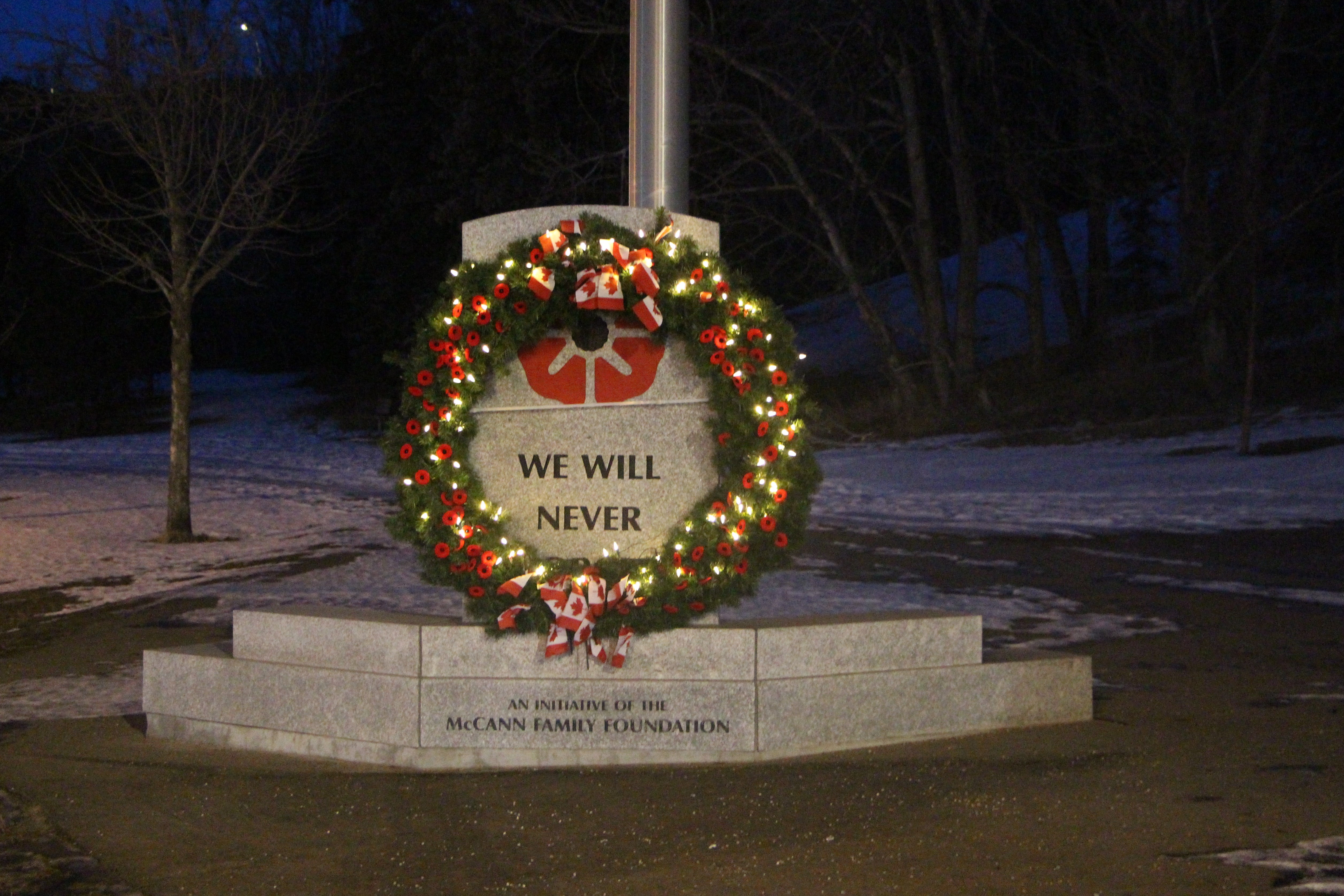
Christmas Wreath
Happy Holidays. Christmas wreath on the Field of Crosses cenotaph adjacent Memorial drive on display until the New Year. Lest we forget.
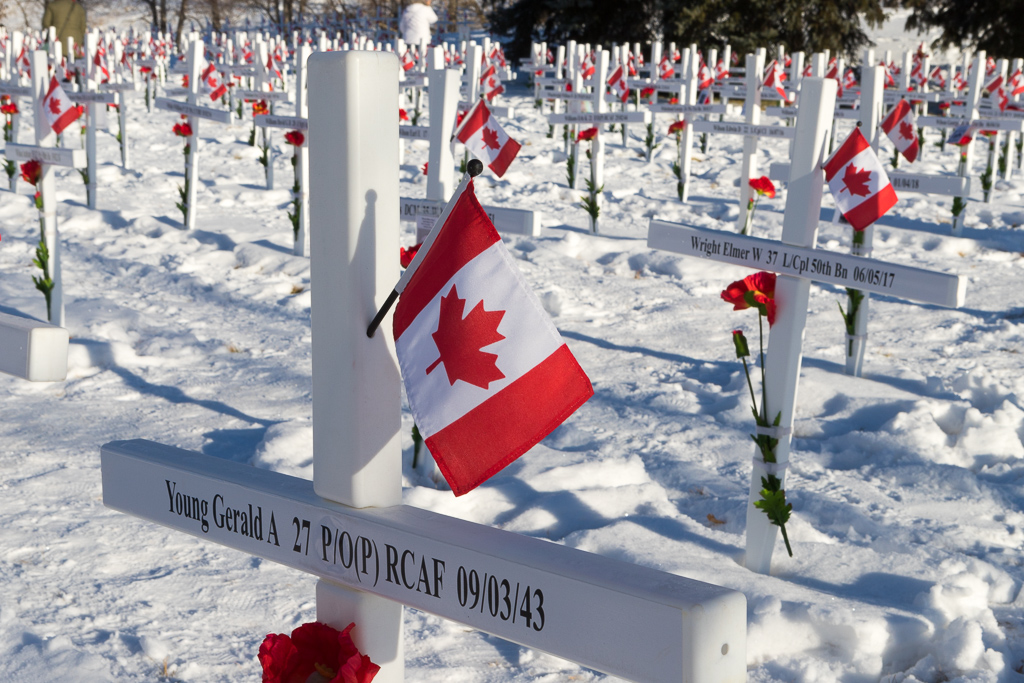
Preparing Crosses.
Dozens of volunteers spent three weekends washing, organizing and bundling nearly 3500 crosses of those Southern Albertans who made the ultimate sacrifice. Global Television was there to share the story and the personal connection many volunteers had to the crosses....
Recent Posts
- Calgary’s Field of Crosses returns for a 16th year to honour Canada’s fallen
- CBC News Network’s Jacqueline Hansen talks Remembrance Day with Field of Crosses Chairman Sean Libin
- Calgary students help resurrect stories of fallen soldiers
- Field of Crosses
- The Field of Crosses Memorial Project begins its fourteenth year
Archives
- December 2024
- November 2023
- November 2022
- October 2022
- June 2022
- November 2021
- October 2021
- November 2020
- September 2020
- August 2020
- November 2019
- October 2019
- December 2018
- November 2018
- August 2018
- June 2018
- November 2017
- October 2017
- November 2016
- October 2016
- November 2015
- October 2015
- September 2015
- November 2014
- October 2013
- November 2012
- October 2012
- November 2011
𝐓𝐔𝐑𝐍𝐄𝐑 𝐀𝐥𝐚𝐧 𝐅
Age: 24 – WO1 (P) RCAF
Date of Death: 05/03/1945
Alan Frederick Turner was born November 13, 1920, in Calgary, Alberta. He was the son of Frederick George and Elizabeth Amy Turner of Calgary. Alan attended Hillhurst School, Balmoral School and Western Canada High School studying electricity and motor mechanics. He was active in basketball and baseball and his hobby was in wireless telegraph. After his schooling Alan was employed with the Canadian National Railway Telegraph and later employed as a taxi and a bus driver.
Alan enlisted in Calgary on February 18, 1941, with the Royal Canadian Air Force, service number R/92602 and trained as a Wireless Air Gunner with the 22 Operational Training Unit. He flew with the Royal Air Force (RAF) 102 Squadron.
While on air operations his Halifax aircraft #W-7918 was shot down over Krefeld, Germany. Alan was reported missing January 27/28, 1943. He was captured on February 22, 1943, and became a Prisoner of War (POW), taken to the German Stalag Camp 344, located outside of the village of Lamsdorf in Southwestern Poland. His POW number was 27384. Camp 344 was comprised of POWs from all over Europe, the Soviet Union, the United Kingdom and Canada. Later in the war many American prisoners were housed there as well.
Alan Turner died of Dysentery while a Prisoner of War on March 5, 1945, he was 24 years old. The camp was liberated March 7, 1945, by advancing Allied Soviet forces.
Warrant Officer Class I (Pilot) Alan Frederick Turner has no known grave, his name is inscribed on the Runnymede Memorial in Surrey, United Kingdom.
Each year during the Eleven Days of Remembrance the Field of Crosses in Calgary, Alberta commemorates Warrant Officer Class I Alan Frederick Turner.
www.fieldofcrosses.com/
#FieldofCrosses #Canada #CanadianArmedForces #History #Calgary
... See MoreSee Less
- Likes: 13
- Shares: 1
- Comments: 2
It is gratifying to read of this project. I’m sure the family’s of the numerous soldiers feel grateful also.
We’d never know about these soldiers if it weren’t for the Field of Crosses writing their stories.
On 17 December 1939, Canada, Great Britain, New Zealand, and Australia agreed to create the British Commonwealth Air Training Plan (BCATP) located in Canada, this plan’s mandate was to train Allied aircrews, including pilots, navigators, bomb aimers, wireless operators, air gunners and flight engineers.
Canada had the flat landscape, very good climate conditions for flying, access to American industry and close enough to Britian to ship men, materials, and planes. Operational Training Units (OTU) were set up in hundreds of communities across Canada. There were 107 schools, 184 ancillary units at 231 sites across Canada, their airfields were staffed and operated by 104,000 Canadians.
Through 1939-1945 more than 131,553 British and Commonwealth aircrew were trained in Canada as part of this Plan. 72,835 graduates joined the Royal Canadian Air Force. 42,110 graduates joined the Royal Air Force, (including 5,425 that came from occupied European countries, such as 2,600 Free French, 900 Czechoslovakians, 677 Norwegians, 448 Polish, 800 Belgian and Dutch aircrew).
The other Commonwealth country graduates included 9,606 Royal Australian Air Force, 7,002 Royal New Zealand Air Force, 5,296 Royal Navy Fleet Air Arm.
In addition, some 6,000 Americans graduated up until December 7, 1941. The Plan would also train approximately 42,500 ground crew tradesmen.
Aircraft built in Canada and utilized by the BCATP included Fleet Fawns, Fleet Finches, Fairchild Cornells, de Havilland Tiger Moths, Avro Ansons, North American Harvard, Bristol Bolingbroke, Noorduyn Norseman and Westland Lysanders.
As the second world war was winding down, the British Commonwealth Air Training Plan was closed on March 31, 1945.
Each November the Field of Crosses in Calgary, Alberta commemorates the 1,074 servicemen and women of Southern Alberta who served with Royal Canadian Air Force (1,010), Royal Air Force (61) and the RCAF Women’s Division (3).
#FieldofCrosses #History #Canada #BCATP #RCAF #RoyalAirForce #BritishCommonwealthAirTrainingPlan
... See MoreSee Less
Reg Smith Nancy Rawson ☺️
My 2 uncle's Ulry . 1 was rcaf and 1 was loyal Edmonton regiment. Killed in line of duty
The Battle of the Rhineland began on February 8th, 1945 after three months of meticulous planning by the Allied forces. This battle was preceded by air and artillery attacks from the Allies in preparation for troop mobilization.
The Battle of the Rhineland was also known as Operation Veritable, and was led by Canadian General Henry Duncan Graham Crerar. The goal of the advance was to drive the enemy back over the Rhine River and into German territory. The First Canadian Army began their advance at the Nijmegen Salient in an attempt to clear the corridor between the Rhine and the Maas Rivers. For the operation to be considered a success, the Canadians needed to clear the Reichswald Forest, clear the defences along the Rhine River, and break the Siegfried Line, which was an elaborate series of bunkers, tank encampments, and trenches along the German border. Through the rain and mud, the Canadian forces advanced beyond the German lines, and by the 21st of February, they had broken through the Siegfried Line.
Once through the Siegfried line, the Canadian First Army was faced with the difficult challenge of defeating the German defences along the Hochwald Forest. The 2nd and 3rd Canadian Infantry Divisions and the 4th Armoured Division assault against these positions began on February 26th. In the beginning, slight gains were made, but the weather made it difficult to progress. On March 4th, 1945, after 6 days of intense fighting, the Canadians cleared the German forces from the forest. The victory at the Battle of the Rhineland was crucial because Canadians had helped to defeat the last major line of German defence.
Throughout the month of fighting the Canadian First Army had 15,634 casualties.
Each November during the Eleven Days of Remembrance, the Field of Crosses in Calgary, Alberta commemorate the Army and Air Force servicemen who lost their lives during the campaign.
www.fieldofcrosses.com/
#FieldofCrosses #Canada #History #WW2 #Veterans #CanadianArmedForces
... See MoreSee Less
These historical pieces you print on Field of Crosses is some shock on the incredible stats. Their success in this endeavour was incredible. What a blow to read the shocking loss of Canadian lives. Thank you for the telling of this truth to honour those who never came home.
Her Majesty’s Canadian Ship Guysborough - J52
HMCS Guysborough (J52) was a Bangor Class minesweeper that served in the Royal Canadian Navy (RCN) during World War II. She was built at Vancouver, British Columbia for the Royal Navy but transferred to the Royal Canadian Navy for manning. HMCS Guysborough was commissioned on April 22, 1942, and assigned to the Western Local Escort Force.
She had a compliment of 83 crew, a displacement of 672 tons and a length of 54.9m (180 ft). She was armed with a single 12-pound gun, 4 20-mm guns and depth charges. Her top speed was 16 knots.
HMCS Guysborough left for Halifax, Nova Scotia in March 1943. She arrived there on April 30 where she joined Halifax Force. In mid-September 1943, Guysborough underwent 6 weeks’ refit at Baltimore, Maryland. In February 1944 HMCS Guysborough left Halifax was assigned to the 14th Minesweeping Flotilla in England. She was present on D-Day.
In December 1944 she returned to Canada for refit at Lunenburg, Nova Scotia. On completion of the refit, she was bound for Plymouth, England, when she was torpedoed and sunk on March 17, 1945, by the submarine U-878 off Ushant Island in the English Channel. Fifty-one of her complement lost their lives, many due to exposure while awaiting rescue over a 19-hour period, while 37 survived and were rescued by HMS Inglis (K 570).
Battle honours earned include Battle of the Atlantic 1943-44 and Normandy 1944. She was also mentioned in dispatches for rescue of a US Navy sub-chaser who suffered a steering gear breakdown in an Atlantic storm in early 1944.
Each November the Field of Crosses in Calgary, Alberta commemorates three Royal Canadian Navy Volunteer Reserv
e (RCNVR) sailors.
Bishop Robert J – 20 – Signalman RCNVR – 18/03/1945
Bodeux Joseph M – 27 – Signalmen RCNVR – 18/03/1945
Mountain William T – 20 - Able Seaman RCNVR – 18/03/1945
All three sailors were lost at sea and are commemorated on the Halifax Memorial in Point Pleasant Park, Halifax, Nove Scotia, Canada.
www.fieldofcrosses.com/
#FieldofCrosses #Canada #History #CanadianArmedForces #Veterans
... See MoreSee Less
𝐊𝐍𝐈𝐆𝐇𝐓𝐒 𝐉𝐨𝐡𝐧 𝐊 𝐃𝐅𝐂
Age: 28 – F/L (N) RCAF
Date of Death: 14/02/1945
John Kingsley Knights was born in Strathmore, Alberta on April 9, 1916. He was the son of John and Bertie Knights of Calgary and brother of Urban, Alice and Verbena. He was the husband to Pansy Alice Knights.
John’s education in Calgary included Glengarry and Sunalta Public Schools and Western Canada Technical School where he studied trades in electricity and motor mechanics. He was active in baseball, skating, shooting and bowling. Following his schooling he worked as a salesman for the West End Nurseries in Calgary. John had previous military training in the militia with the 91 Field Battery ‘Signals’ for three years from 1933 to 1936.
John enlisted on November 6, 1940, with the Royal Canadian Air Force, initially flying with the 408 Squadron. He was awarded the Distinguished Flying Cross on May 7, 1943. His citation read; “Since joining this squadron Pilot Officer Knights has taken part in attacks against some of the most heavily defended targets in enemy territory. These operations included sorties to Cologne, Dusseldorf, Lorient, Essen, Breman, Hamburg and Turin, amongst others. Invariably this Officer has shown a fine fighting spirit and courage of the highest order. At all times his efficient navigational skill and judgement have been an inspiration to the other members of his crew.”
Due to his navigation skills, he was taken on strength on February 9, 1945, with the 405 Squadron, a Path Finder Force. Their moto in Latin was ‘Ducimus’, meaning ‘We Lead’.
John completed 35 missions and had just begun his second tour of operations. On the evening of February 13, 1945, he and the crew of their Lancaster, (registration: PB183, main serial number LQ-C), took off from RAF Gransden Lodge Air Force base to take part in Operation Thunderclap with the bombing on Dresden, Germany.
In the stream of bombers heading to the target, still carrying their full bomb loads, two aircraft collided in mid-air creating a large explosion and the loss of both aircraft and crews over Remlingen, Germany. The aircrafts identified were the one John was flying in and another from the 576 Sqdn, Lancaster # PD232.
As a result of the crash, 11 crew members perished and are buried in the Durnbach War Cemetery in Gmund am Tegernsee, Bavaria, Germany, three were never found and are commemorated on the Runnymede Memorial, and one was taken as a prison of war.
John was reported missing and presumed killed in action on February 14, 1945, at the age of 28. Flight Lieutenant Navigator John Kinsley Knights has no know grave and his name is inscribed on the Runnymede War Memorial at Englefield Green, Egham, Surrey, England.
Each year during the Eleven Days of Remembrance the Field of Crosses in Calgary, Alberta commemorates Flight Lieutenant John Kinsley Knights.
FoC/BPeake
2025-02-10
www.fieldofcrosses.com/
#FieldofCrosses #Canada #Calgary #History #CanadianArmedForces
... See MoreSee Less
Amazing research to bring back these vivid details. It makes it so personal. Thank you for the story of this young talented man.
This is so cool to find.. He was my great Uncle.
Wow

